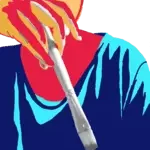
LONG POST ALERT!
In my previous post, I stretched on the importance of connecting with an art medium and how to find your motivation to continue making art. If you are reading this, you have either decided to continue working on watercolors or maybe you are curious about the subject.
Anyway, this post sheds light on the next logical step which I like to call as the holy trinity of watercolor paintings. This focuses on the right usage of paper, pigments and brush which play a fundamental role in how you proceed to develop your own style with this medium.
Also, watercolors demand a lot of practice, and practice means exhausting resources. Your beginner level paintings may look frustratingly nasty, but if you are tenacious enough, you WILL use/waste a lot of resources. With focus on sustainability and efficiency, this post also shares some tips and ideas on how you can reduce wasting resources while not compromising on practice. By the end of this post, you should be able to:
- Understand technical descriptions of papers and choose from brands available to you
- Know what makes a good paint and why they need not be expensive
- Experiment with few brushes and find the ones that feel like an extended arm
- Do all the above without burning a hole in your pocket
Papers: The GSM Dilemma
For most of us, in some parts of our lives we engage with some form of visual creation, even if it means scribbling or making paper crafts for school projects. The interaction we have with “type” of papers is very limited unless some of us actually choose to opt for studies which demand paper-knowledge. As such, looking for papers for watercolor painting can be quite a daunting exercise. Moreover, terms like “hot pressed”, “cold pressed”, “pound/gsm”, and numbers floating around them make it even more difficult.
Let’s approach this problem little more logically. The interaction of water and a regular paper is known – paper thins and tears away. Naturally, for making watercolor paintings we would need papers that can withstand the needed amount of water without warping or tearing away.
This is where “gsm” comes in. It is an acronym for Grams Per Square Meter. Simply put, the more the gsm value, the thicker the paper. It can range from 180 to as high as 640 (for recycled ones). Now coming to the hot vs cold pressing, these terms indicate paper’s texture.
Papers labelled cold pressed feel textured or rough while the hot pressed ones feel smooth. I haven’t worked with hot pressed papers yet and hence I would rely on what other watercolorists suggest for beginners. They recommend cold pressed and since I use these papers and they are more abundantly available, I would recommend the same.
Now what brands to choose?
With all the technical knowledge so far, you should now be able to discern which papers can be used for watercolors and which cannot. I would recommend you to go with a 300 gsm cold pressed paper of size A5.
The brands available at your location can vary from country to country. In Bangalore, India, brands like Brustro or Mont Marte are easily available. Handmade papers with label CONECO is my new discovery and currently in use.
Brustro’s build is pretty sturdy and even if you make a mess on one side of the paper, you can flip it paint on the other side. It’s available on Amazon and comes at a very reasonable price.
Mont Marte’s build is comparable to that of Brustro’s but it is textured only on one side. The other side is quite smooth and I am not sure if painting on the smooth side is analogous to painting on a hot pressed paper. Would love to be enlightened about it, please leave a comment if you know. Additionally, A5 size Mont Marte is something I couldn’t find and this brand is little expensive compared to Brustro.
CONECO’s papers are handmade and hence they do not carry the same paper-color consistency as the other two. Additionally, drawing on them becomes illegible once you start to painting layers, and peeling off masking tape takes up paper particles as well. Not something I would recommend if you are starting out.
So, if you are absolutely new to watercolors, pick Brustro, cold pressed, A5 papers.
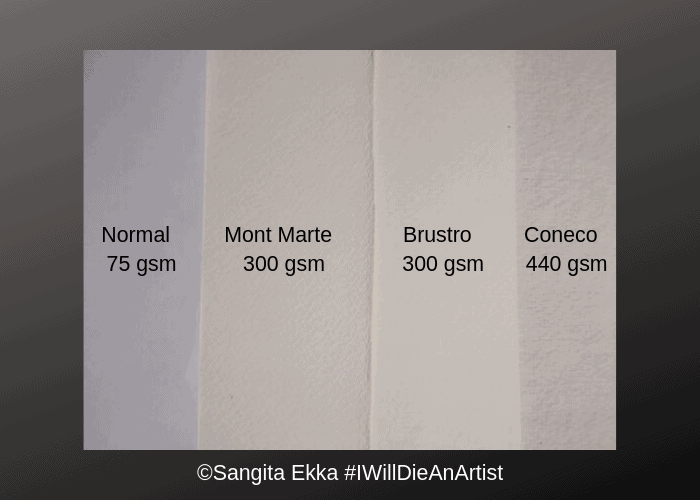
Pigments: What are they anyway?
Watercolor paintings can either be transparent or opaque. The most common method is transparent, the kind that feels dreamy and lighted. The opaque method aka Gouache gives off a matte finish and feels more pigmented. Depending upon the kind of watercolor painting you want to make, you choose the pigments.
Without getting too technical, know that when you are drawing paint from tubes or adding water to dry cakes, you are mixing finely ground pigments which impart color to your painting. Pigments exist in the paint with water soluble binders that hold the pigment which adheres to paper on application.
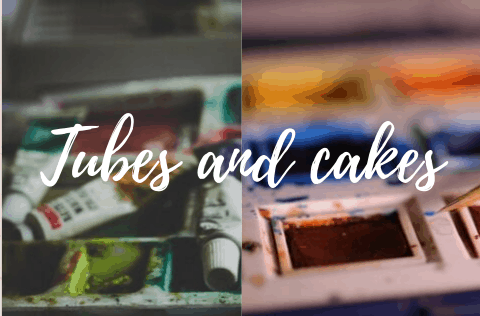
Most common technique is transparent but if you are intrigued by opaque techniques you can try them too. Manufacturers often mention the type on the color set. The paper requirement and application techniques don’t change. I once used a transparent tubeset in which the pigments and binder were separated. The consistency of the paint varied in different tubes in the same set. As a result, the colors on paper were dull, wrong and lifeless.
Coming to brands, you might have come across names like Winsor and Newton, Daniel Smith, Sennelier and maybe more. These are world class paints and obviously expensive. If money is not an issue, buy them but there are cheaper alternatives which are good paints too and logically it makes more sense to invest in them when you are learning. 2 years back I bought Bianyo tubes, and paint in my tubeset is still good. It carries rich pigment, making the paintings look vivid, the paint doesn’t dry in the tubes and this brand comes at a much cheaper price. I would personally recommend you to try this.
Brush: Which one is the right one ?
Now this is the topic where I have struggled the most. When I seriously started painting with watercolors , I picked up a brush set of both round and square types which were made up of synthetic fibres. They were cheap and decent to use. However with time, the bristles start to spread and the round brushes don’t maintain the pointy tip. The retention of water and pigments also reduce and scattered bristles run the risk of scattering paints at unintended places.
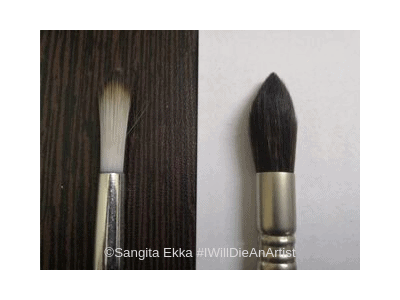
Square brushes on the other hand are not considered as versatile as round brushes but I have involved myself in paintings which were carried completely by them. Stan Miller’s tutorials on making watercolor portraits suggest beginners to go with a 1 inch brush. Do watch these tutorials if you are interested to paint portraits, his works look life-like on paper, almost giving the impression of people “coming out” from the sheets.
After experimenting with multiple brands and some research, I have settled for Escoda Ultimo Size 10. May look expensive to some but this is really handy while doing large scale washes and holds water and pigment really well.
For smaller thin details I have picked a few lower range local brand’s brushes of sizes around 2-4. With my experiments so far, I believe that a brush size preference and the type is something you pick up during the process.
There is no one recommendation which fits all. Having said that, it is also important to have one good quality round brush of size 8 or 10. Escoda is one good brand that I could easily order and I am happy with the results.
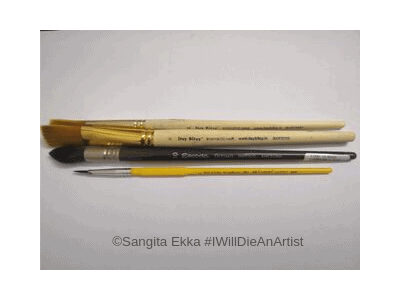
If you have access to more brands, please do your research, read reviews, check for what other artists suggest and then make the purchase. This article can be of use to you.
Tips to reduce resource wastage
- We know watercolor papers come with different sizes but if you are at the initial learning phase, try to work only with A5 papers for a year. If you buy larger size papers, cut them into smaller sizes and paint. This way you don’t waste papers while making bad paintings (which you will).
- Learn how to be diligent and yet generous with your use of pigments. I have a special kind of hatred for people who WASTE tons of colors in the name of “abstract art”. Pigments are fetched from natural resources and unless there is a really good intention, good knowledge and a good painting outcome, it’s just resource wastage.
- Buy a size 6 or size 8 when you are starting out. And a size 2 for some finer details. Observe how comfortable you are and then try different brushes till you find what you are actually comfortable with. This is a self-discovery process.
- Buy artist grade art supplies against student grade. Reason – better quality.
- Plant trees or donate for afforestation because papers don’t grow in nature.
Knowledge of paper, pigments and brush is central to making watercolor paintings. It took me sometime to understand their dynamics while I fetched for this knowledge from different sources. This blog, although long was intended to put their dynamics and interdependency at one place. I hope this helped you. Do let me know in the comments. In the next section we will look into the setup before we jump into techniques. Keep calm and paint!
Quick Links:
*Amazon India links and local shop websites
- Brustro Artists Watercolor Papers, 300 gsm, Cold Pressed, A5: Link
- Mont Marte Watercolor Papers, 300 gsm, Cold Pressed, A4: Link
- Coneco Handmade Watercolor Papers, 320 gsm, Cold Pressed A4: Link
- Coneco Handmade Artist Grade Watercolor Papers, 440 gsm, Cold Pressed, A5: Link
- Bianyo Artist Quality Watercolor Tubes: Link
- Escoda Ultimo Tendo Synthetic Squirrel Hair Brush: Link
- Watercolor Brushes KnowHow: Link
